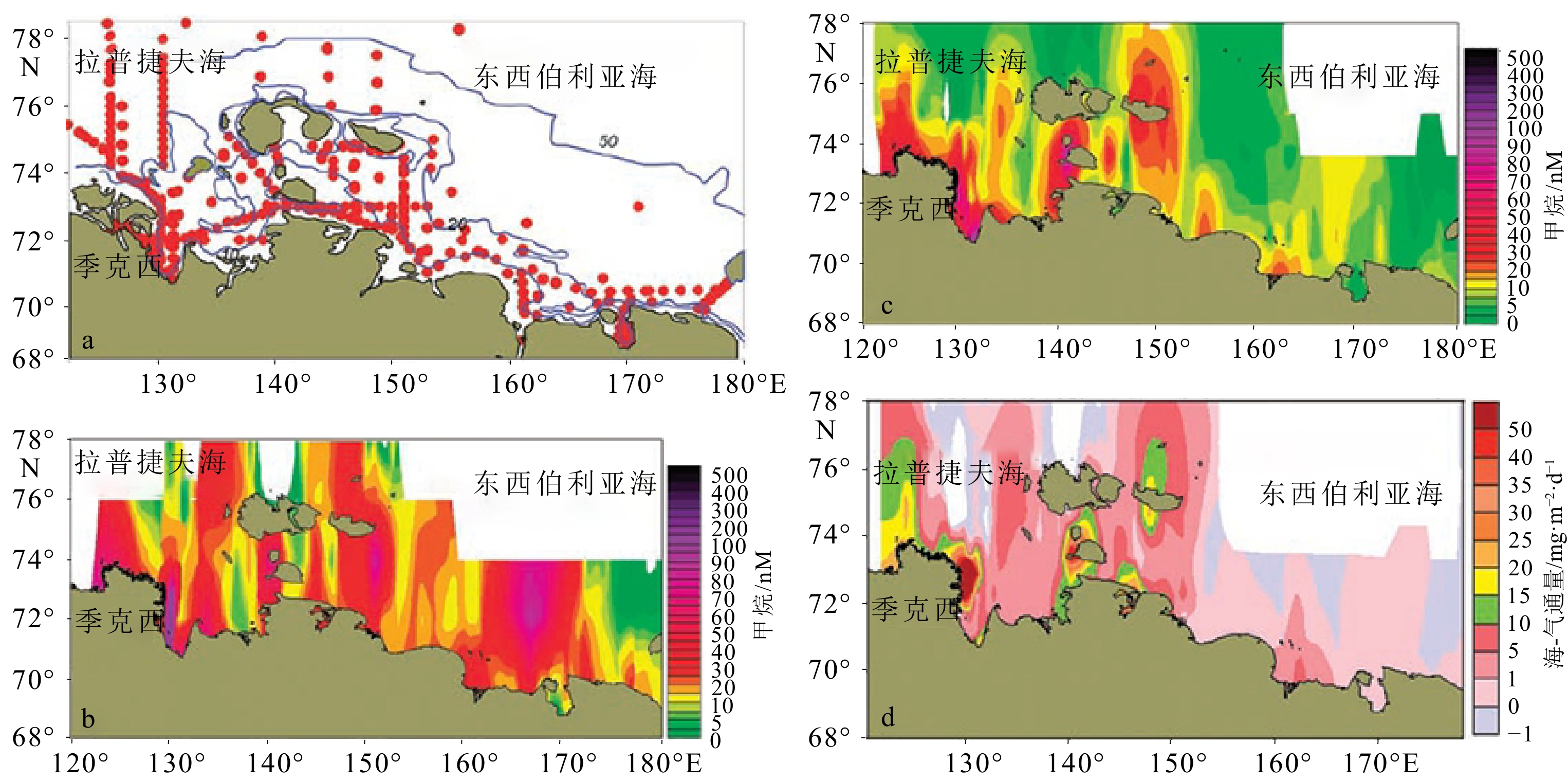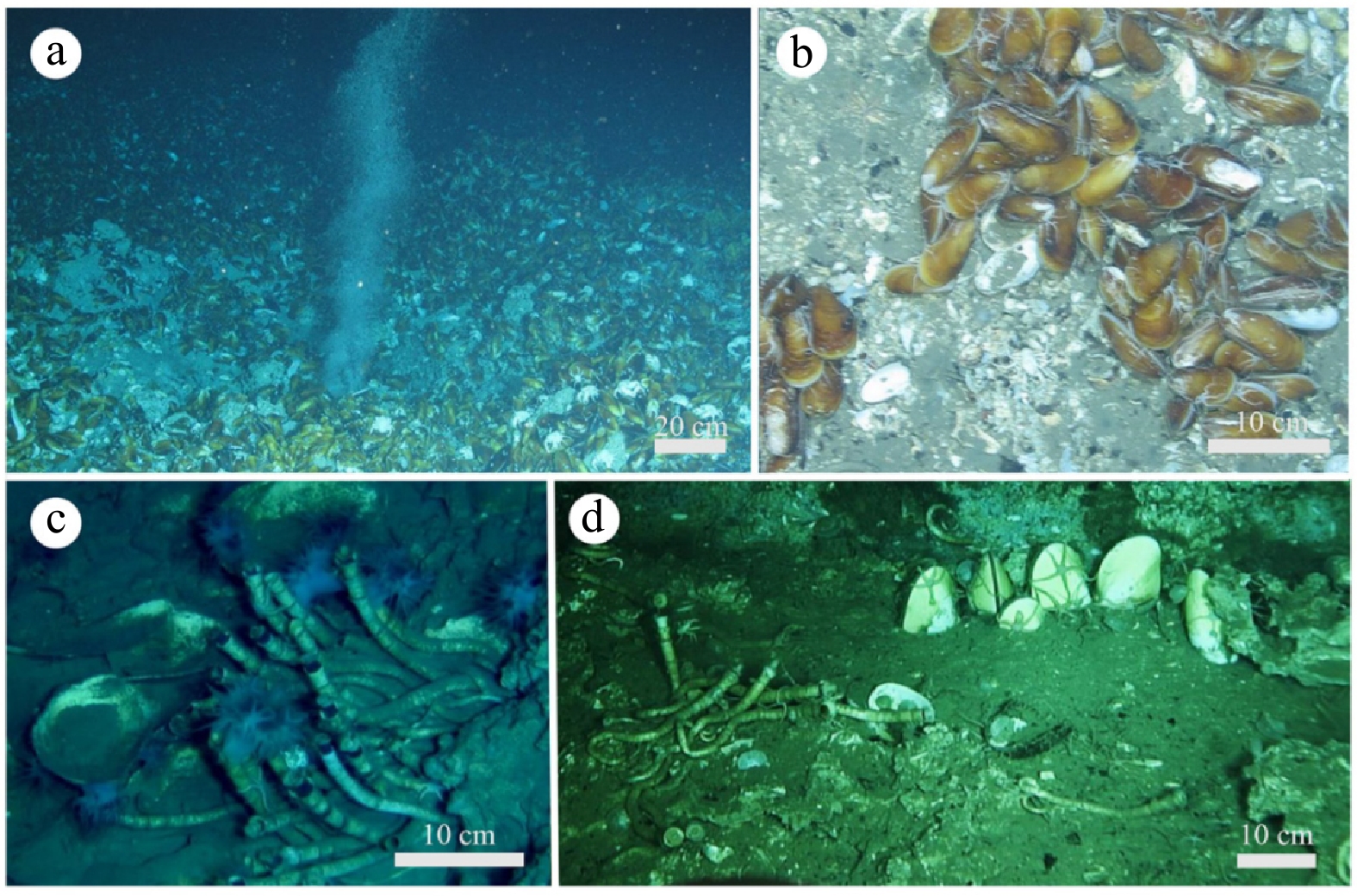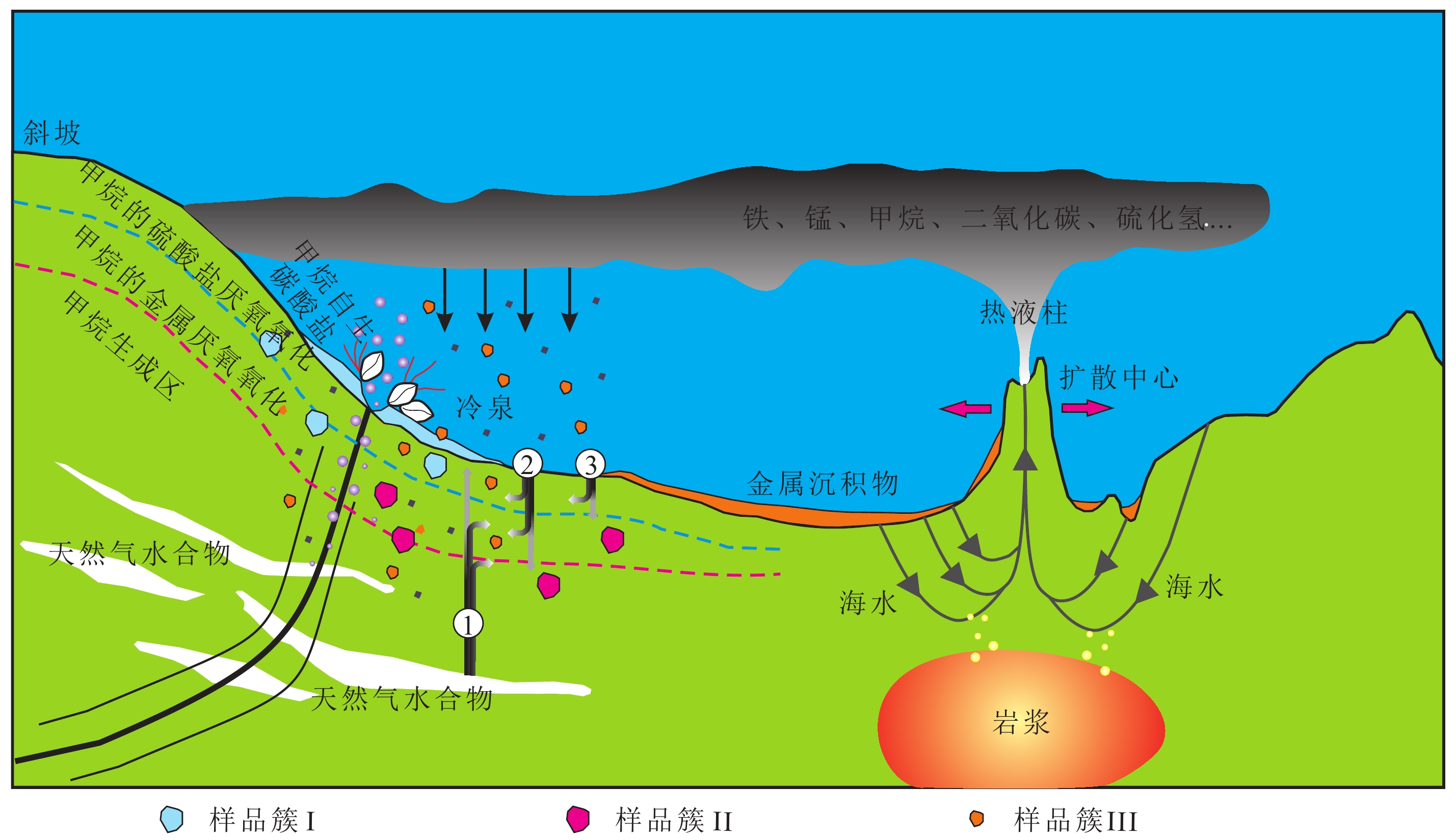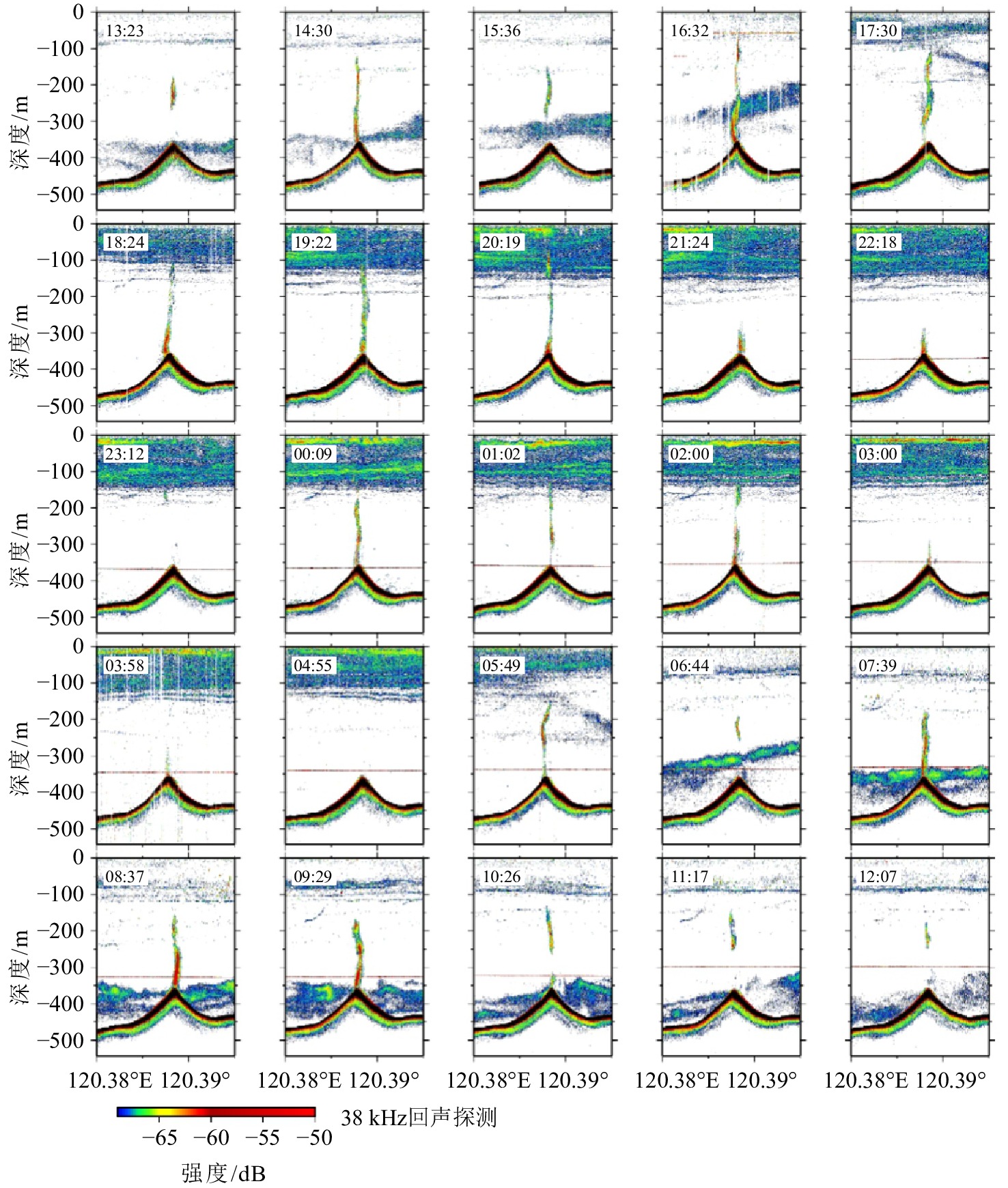Observation and research progress of modern oceanic methane cycle
-
摘要: 当前出于对全球气候变化的担心以及获取能源资源的需求,甲烷日渐成为人类社会关注的焦点。海洋中聚集了巨量的天然气水合物,存在与甲烷有关的多种重要生化作用,支持了海底繁盛的化能自养合成生物群落,有效调节了进入大气的甲烷通量,在全球碳循环中的地位无可替代。同时,因天然气水合物动态活动造成的甲烷泄漏是岩石圈向外部圈层进行物质和能量输送的重要途径,对海洋环境有着深远影响。系统介绍了现代海底甲烷泄漏的地质控制因素、沉积物和水体对富甲烷流体的消耗、海洋甲烷循环模拟研究以及全球典型海域甲烷观测及相关研究成果,最后指出了海洋甲烷循环研究发展趋势。综合考虑了环境、生物和技术因素对海洋甲烷循环的影响和限制,从一个地质工作者的视角对阶段成果和存在问题进行审视,并提出了自己的思考,借此引发全社会对与甲烷有关的重大科学问题及海洋观测技术的重视与支持。Abstract: Out of concern for global climate change and the demand for energy resources, methane has increasingly become the current focus of human society. A large amount of natural gas hydrate is stored in the ocean, which has many important biochemical reactions related to methane, supports the prosperous chemoautotrophic synthetic biological community on the seabed, effectively regulates the methane flux into the atmosphere, and plays an irreplaceable role in the global carbon cycle. At the same time, methane seepage caused by the dynamic activity of natural gas hydrate is a critical way to transport material and energy from the lithosphere to the outer sphere, which has a far-reaching impact on the marine environment. In this paper, we systematically introduce the geological control factors of modern seabed methane seepage, the consumption of methane by sediments and water columns, the simulation research of marine methane cycle, the methane observation and relevant research results in typical sea areas, and finally points out the development trend of marine methane cycle research. This review comprehensively considers the influence and limitation of environmental, biological and technological factors on the marine methane cycle, examines the temporary achievements and existing problems from the perspective of a geologist, and puts forward our own thinking, hoping to arouse the attention and support of the whole society to the major scientific problems related to methane and subsequent marine observation technology.
-
2021年,《中美关于在21世纪20年代强化气候行动的格拉斯哥联合宣言》强调了甲烷(CH4)排放对于升温的显著影响,认为加大行动控制和减少甲烷排放是21世纪20年代的必要事项。这充分凸显了甲烷在全球气候和环境中的重要地位。与河口海岸带和湿地相比,海洋来源的甲烷由于对大气甲烷收支较小的贡献(约2%)[1],过去一直受到忽视。然而,近年来的研究表明,海洋甲烷的意义远不止是其对大气贡献这一个指标所决定的,地质历史时期由于海洋甲烷大规模泄漏导致的气候和环境灾变也逐渐引起了关注[2-4]。对海洋甲烷循环开展研究具有如下几方面意义:
首先,可促进对全球气候变化机理的深入认识。目前,全球每年的甲烷排放量约为555 Tg[5],自工业革命以来已增加了2.5倍。海底以天然气水合物形式(以下简称“水合物”)储集在沉积物内的甲烷存量推测是当前大气圈中甲烷总量的150~3 000倍之多[1],即使按中位数计,海洋对甲烷储存效率上发生1%的波动,也可能使大气中的甲烷含量增加数十倍[6]。开展典型海域甲烷循环研究,可加强对全球气候变暖机制的理解和预测。
其次,有助于与甲烷有关海洋资源的勘探和开发。海洋甲烷流体的迁移和重要能源矿产资源的聚集密切相关,甚至直接参与矿产的形成。例如,海底冷泉喷口是水合物和常规油气资源的重要勘探标志,尤其对浅表层水合物资源而言[7]。因此,寻找水合物分解泄漏流体形成的冷泉,也是浅表层水合物和常规油气田资源勘探的重要工作。
再次,加深对地球系统科学和生命科学重要问题的理解。海底甲烷流体的形成、转移和消耗均涉及一系列重要的生化反应[5],以甲烷为能量基础的一系列化学作用是否成为包括行星、卫星在内的许多天体上生命存在的条件,也是天文生物学研究的一个重要方向[8]。因此,海洋甲烷过程的研究有助于更好地理解生命起源与演化等重要科学问题,是当前地球系统科学和生命科学交叉研究的热点领域。
1. 国内外研究现状
地球上超过99%的水合物赋存在大陆边缘沉积物中[9]。在各种因素作用下,水合物失稳分解,产生的富甲烷流体通过地层中的通道系统向上运移到海底,形成冷泉系统。实际上,常规油气富集区上部也容易产生烷烃泄漏[6,10],海底蛇纹石化[11]和热液喷口流体也能释放一部分烷烃[12],它们都是海洋甲烷的重要来源。海洋甲烷泄漏研究的焦点问题是其形成分布的控制机理、在海洋中的行为以及对大气的贡献[5]。由于海底冷泉流体来源多样,本文主要探讨海洋水合物分解流体形成的冷泉。下面简述在这些方面的研究现状。
1.1 水合物分解释放富甲烷流体过程的地质控制因素研究进展
在全球范围内,从高纬度到低纬度,在大陆坡的整个水深范围内均发现了水合物分解泄漏形成的海底冷泉,如在巴伦支海Hornsund断裂带内,探测到1 200多处气体泄漏点[13],北大西洋极地的熊岛海槽发现600多处泄漏点和相应的弹坑状结构[14](图1),墨西哥湾北部水深大于200 m的区域识别出约5 000处泄漏点[15],西伯利亚东部浅海区探测到27 000处泄漏点[16]。初步估算,全球因水合物泄漏同时正在喷发的冷泉泄漏点数量可能超过数十万个。
![]() 图 1 北大西洋极地熊岛海槽发现冷泉泄漏点和相应的似陨石坑地貌三维测深图结合二维地震剖面显示沉积物中气体存在(相位反转反射特征以及气烟囱),棕色线指示断层[14]。Figure 1. Cold seep leaks and corresponding crater-like landforms found in the North Atlantic polar Bear Island Trough3D bathymetry combined with 2D seismic profiles showing gas presence in sediments (phase-reversed reflection and gas chimneys), Faults are indicated by brown lines [14].
图 1 北大西洋极地熊岛海槽发现冷泉泄漏点和相应的似陨石坑地貌三维测深图结合二维地震剖面显示沉积物中气体存在(相位反转反射特征以及气烟囱),棕色线指示断层[14]。Figure 1. Cold seep leaks and corresponding crater-like landforms found in the North Atlantic polar Bear Island Trough3D bathymetry combined with 2D seismic profiles showing gas presence in sediments (phase-reversed reflection and gas chimneys), Faults are indicated by brown lines [14].发生如此规模泄漏活动的通常是位于水深较浅位置、埋藏较浅并且与断裂/层或者与特殊地质体(气烟囱、底辟、泥火山等)相连的水合物储层失稳造成的[17], 主要地质和环境因素通常包括:
① 异常超压。当海洋沉积物孔隙中烃类聚积,压力达到足够高时,就会穿过水合物稳定带向上迁移[18],而水合物在稳定带边缘的分解也能在其上部形成相当数量的水力裂缝,又成为气体迁移的理想通道[19];② 区域环境波动。如地震活动[20]、风暴过境[16]、潮流循环[21]、冰川消融[14]、底水温度波动[22]等;③ 峡谷水道、底辟以及泥火山等活动地质体的侵蚀。如海底峡谷侵蚀作用及峡谷侧壁沉积物的失稳[23],会导致含水合物盖层或储层遭受侵蚀,使得水合物层失稳分解,由此产生的气体将会从峡谷边缘缺口渗漏至海底[24-25];④ 全球性环境巨变。地质历史时期全球性的海平面剧烈波动和气候迅速升温,都可能引发水合物的灾难性的分解释放。例如,推测古新世‒始新世极热事件(PETM)期间,分解并逃逸到大气中的水合物甚至达到2 100 Gt[2]。
由于触发因素众多且复杂,水合物释放的甲烷在时空上又具有高度易变性[6,26],目前对海底水合物泄漏流体在海洋中的运移和变化认识仍存在盲区,主要体现在对沉积物和水体作为甲烷汇的了解不够[5],同时对于逃逸甲烷被消耗的机理和控制因素也掌握不足,导致无法准确评估海洋中甲烷通量的行为和归宿。
1.2 “底栖过滤器”对富甲烷流体的消耗研究进展
海底甲烷流体泄漏后,依次遭受沉积物中甲烷厌氧氧化反应(AOM)和沉积物表层充氧带和上覆水体中好氧氧化反应(AeOM)消耗,剩余部分将穿越“海-气”界面进入大气。前人将沉积物中的AOM称为甲烷的“底栖过滤器”(benthic methane filter)[27],该带在空间上对应着硫酸盐-甲烷过渡带(SMTZ),是沉积物中甲烷的一个强汇;对应地,在本文中将AeOM称为甲烷 “水体过滤器”,在空间上对应着沉积物上部充氧带和从“沉积物-海水”界面之上一直到“海-气”界面的含氧水柱,也是海洋甲烷次重要的汇。下面具体介绍有关这两个“甲烷过滤器”(甲烷汇)观测与模拟的最新进展。
1.2.1 “底栖过滤器”对甲烷流体的消耗原理
沉积物中的水合物分解释放后,主要以3种运动方式进入沉积物中:分子扩散、孔隙水对流(此二者主要以溶解态)以及游离态气泡上升[1,28]。“底栖过滤器”(对应沉积物中的AOM)对于这3种甲烷运移方式具有不同的拦截作用和消耗能力。
首先,在SMTZ带内,以分子扩散方式向上运移的甲烷几乎被AOM(反应1)消耗殆尽。反应1为经典的硫酸盐还原驱动的AOM(sulfate-AOM),已经广为接受;但当前一系列调查和研究又发现,活性金属还原驱动的AOM(metal-AOM)在海洋沉积物中也相当普遍[29-30](反应2、3)。近期,在我国东海和南海的相关研究中也都发现了metal-AOM的证据[31-32]。通常情况下,在以扩散作用为主的SMTZ内,进入水圈的甲烷通量几乎完全被AOM所控制[1,28],深刻影响了从海底排放到海水中的甲烷数量[1,33]。AOM的终产物主要为溶解无机碳、硫化氢和溶解有机碳[34]。同时,由于碱度的存在,AOM可使被氧化甲烷中约10%~20%的比例沉淀为碳酸盐[35]。
$$ \mathrm{C}{\mathrm{H}}_{4}+\mathrm{S}{{\mathrm{O}}_{4}}^{2-}\to \mathrm{H}\mathrm{C}{{\mathrm{O}}_{3}}^-+\mathrm{H}{\mathrm{S}}^-+{\mathrm{H}}_{2}\mathrm{O} {\text{(反应 1)}} $$ $$ \begin{aligned}\mathrm{C}{\mathrm{H}}_{4}+8\mathrm{F}\mathrm{e}{\left(\mathrm{O}\mathrm{H}\right)}_{3}+15{\mathrm{H}}^+\to \mathrm{H}\mathrm{C}{\mathrm{O}}_{3}^-+8\mathrm{F}{\mathrm{e}}^{2+}+21{\mathrm{H}}_{2}\mathrm{O} \\ {\text{(反应 2)}} \end{aligned}$$ $$ \mathrm{C}{\mathrm{H}}_{4}+4\mathrm{M}\mathrm{n}{\mathrm{O}}_{2}+7{\mathrm{H}}^+\to \mathrm{H}\mathrm{C}{\mathrm{O}}_{3}^-+4\mathrm{M}{\mathrm{n}}^{2+}+5{\mathrm{H}}_{2}\mathrm{O} {\text{(反应 3)}} $$ 其次,在以孔隙水对流为主要泄漏方式的冷泉区,流速控制了甲烷被消耗的过程。Karaca等[36]发现在中等强度孔隙水对流区AOM速率最高,即当对流速率为40 cm·a−1时AOM速率最大,达到2.3 mmol·cm−2·a−1;与之相比,在强、弱对流区则较低,如当对流速率为200 cm·a−1和<10 cm·a−1时均低于1 mmol·cm−2·a−1。尽管如此,甲烷的转化效率(即AOM消耗的通量/向上运移的通量),仍然随孔隙水对流速率的降低而升高。这与Wallmann等[37]对黑海冷泉研究结果相符,即当孔隙水对流速率分别为1、10和100 cm·a−1时,相应地有99%、91%和34%的甲烷通过AOM转化为溶解无机碳(DIC),剩下的1%、9%和66%的甲烷则直接被释放进入水体。
第三,以游离态气泡运移的甲烷,在SMTZ带被AOM拦截消耗的程度最低。在冷泉流体供应丰富区由于经常处于过饱和状态,孔隙水中的甲烷就会出溶形成气泡,然后以对流方式沿着通道系统向上逃逸[38],形成气泡羽流(gas plume),在声学剖面上对应着所谓的“火焰状异常”(gas flare)。此时,“底栖过滤器”对甲烷的消耗非常有限,原因有两个:一方面,流体快速上升使细粒沉积物和微生物难以保存在通道及周围[39];另一方面,当对流(比如喷发)发生时,微生物对流体中的甲烷的氧化能力相对有限,难阻其进入上部水体中[40]。因此,流速也是控制游离态甲烷消耗程度的首要因素。底栖生物对于低速甲烷流体的消耗效率约为80%,对中速甲烷流体缩减到约20%[6],而在发生强烈喷发的区域,其消耗效率甚至低于10%[27]。如在东西伯利亚北极大陆架,水深普遍<50 m,海水为气泡羽流向大气释放提供了一个非常便捷的通道,尤其是暴风雨时期,大量的甲烷绕开了“底栖过滤器”的消耗而释放到大气中[16]。
1.2.2 “底栖过滤器”效率的模拟
由上面的讨论可知,沉积物中甲烷运移消耗的一个关键问题是“底栖过滤器”的拦截或消耗效率问题。当在更大区域上对其进行效率评估时,还要考虑到泄漏活动在空间上的随机性以及时间上的易变性。对上述因素考虑不足,就会加剧海洋甲烷收支模型的不确定性[1,33]。
沉积物“底栖过滤器”作为甲烷的一个强汇,自发现伊始,就吸引了众多的研究兴趣,除了开展详细、系统的观测外,对其消耗效率问题也应用了数值模拟办法,如建立“运移‒反应”模型(Reaction-Transport Model)[41],目前已经提出了多个模型:
早期认为,AOM反应的速率主要与甲烷和硫酸盐的浓度有关,当甲烷和硫酸盐的浓度越高时,AOM作用越强烈,消耗的甲烷、硫酸盐越快,见模型1[42]:
$$ {R}_{\mathrm{A}\mathrm{O}\mathrm{M}}={k}_{\mathrm{A}\mathrm{O}\mathrm{M}}\cdot \left[\mathrm{C}{\mathrm{H}}_{4}\right]\cdot \left[\mathrm{S}{{\mathrm{O}}_{4}}^{2-}\right] {\text{(模型 1)}} $$ 不但如此,Nauhaus等[43]还对模型1做了修正,来表述低硫酸盐浓度对AOM效率的抑制作用:
$$ {R}_{\mathrm{A}\mathrm{O}\mathrm{M}}={k}_{\mathrm{A}\mathrm{O}\mathrm{M}}\cdot \left[\mathrm{C}{\mathrm{H}}_{4}\right]\cdot \frac{\left[\mathrm{S}{{\mathrm{O}}_{4}}^{2-}\right]}{{K}_{\mathrm{S}}+\left[\mathrm{S}{{\mathrm{O}}_{4}}^{2-}\right]} {\text{ (模型 2)}} $$ 随后的研究又表明,沉积物中微生物对底物的消耗通常表现出饱和的能力,也就是说,随着微生物、甲烷和硫酸盐底物浓度的增加,反应速率最终会随时间达到最大值vmax。当反应速率等于vmax一半时的底物浓度称为半饱和常数,并使用参数Km来表示酶对底物亲和力的量度,即Km越低,亲和力越强,以上过程可以用模型2表示[44]:
$$ {R}_{\mathrm{A}\mathrm{O}\mathrm{M}}={v\frac{\left[\mathrm{C}{\mathrm{H}}_{4}\right]}{{K}_{\mathrm{m}}^{\mathrm{C}{\mathrm{H}}_{4}}+\left[\mathrm{C}{\mathrm{H}}_{4}\right]}\frac{\left[\mathrm{S}{{\mathrm{O}}_{4}}^{2-}\right]}{{K}_{\mathrm{m}}^{\mathrm{S}{{\mathrm{O}}_{4}}^{2-}}+\left[\mathrm{S}{{\mathrm{O}}_{4}}^{2-}\right]}}_{\max} {\text{ (模型 3)}} $$ 与溶解态甲烷相比,气泡羽流的甲烷通量更高,运移速度更快,气泡中游离态的甲烷无法明显地被微生物AOM反应消耗[45]。但由于浅层沉积物中孔隙水的甲烷浓度低于饱和浓度,因此,仍有一部分游离态甲烷在浅层沉积物中会再次被溶解,参与AOM反应。在孔隙水中溶解甲烷浓度低时,气泡的溶解速度快;而在孔隙水中溶解甲烷浓度高时,气泡的溶解速率则降低。以上过程可以用模型4来表示:
$$ R_{\rm{MB}}=K_{\rm{MB}}(L_{\rm{MB}}-[\rm{CH}_4]) {\text{ (模型 4)}} $$ 目前,关于甲烷以气泡形态在裂缝中的运移过程的模拟还存在如下不足:首先,针对沉积物中甲烷的模拟主要是一维运输反应模型,无法描述沉积物中裂缝、溶洞等空间结构对气泡扩散的影响;其次,已有模拟针对的对象只是经典的sulfate-AOM(反应1),未纳入新发现的metal-AOM(反应2和3)的作用;此外,未充分考虑气泡运移过程中气泡形态的变化、孔隙水中溶解甲烷的饱和程度,以及气泡在沉积物中的吸附等问题。
1.3 “水体过滤器”对富甲烷流体的消耗研究进展
1.3.1 “水体过滤器”对冷泉流体的消耗原理
当水合物分解泄漏流体从沉积物SMTZ中进入上部充氧带和上覆海水后,就要面临着“水体过滤器”(对应AeOM,见反应4)的消耗,该过程直接决定着进入大气圈的甲烷净通量。据前人估算,从海底逃逸的甲烷通量(主要是气泡羽流)大约有90%在到达大气之前又被“水体过滤器”消耗[1]。实际上,AeOM的分布范围很广,可存在于水深超过3 000 m的深海沉积物及水体中[46],其氧化速率也可能显著高于AOM速率,甚至相差50倍[47],部分海域AeOM的甲烷拦截效率甚至达63%[48]。因此,AeOM对海洋甲烷的消耗作用也不可忽视。
$$ \mathrm{C}{\mathrm{H}}_{4}+2{\mathrm{O}}_{2}\to \mathrm{C}{\mathrm{O}}_{2}+2{\mathrm{H}}_{2}\mathrm{O} {\text{ (反应 4)}} $$ 对于AeOM消耗的研究主要考虑两个问题:从沉积物中进入海底的甲烷通量和AeOM的消耗效率。对于前者,目前已经有较多的观测研究实例。如对Håkon Mosby泥火山的调查结果表明,从该火山中每年释放的甲烷通量可达(2.0~6.4)×108 g,其中约40%分别被AeOM消耗(比例为1%~3%)和AOM消耗(比例为37%)[49]。还有观测表明,每个泄漏点每年可向水圈释放的甲烷量为10~100 t,而海底一座单独的泥火山甲烷的每年排放量也可达到数千吨[6]。
对于在“水体过滤器”内的甲烷消耗效率,影响因素较多,主要包括:①水深;②流体释放通量的时、空分布;③气泡本身的特征,如尺寸、有无油膜或水合物包壳等[50];④海洋跃层;⑤海水溶解氧浓度、温度、盐度、密度以及营养物的可利用性[51]等;⑥洋流[52]。最近一项研究表明,斯瓦尔巴群岛西部海域水合物泄漏的气泡羽流导致底层水中溶解甲烷浓度高达825 nM,致使甲烷在“海-气”界面上输送;而对更大范围水体调查研究后发现有0.02%~7.7%比例的溶解甲烷遭受了AeOM的消耗,仅有一小部分(0.07%)在低风速时期转移到大气中[53];但与此不同的是,在对Håkon Mosby泥火山的调查中发现甲烷碳同位素组成与甲烷源区的组成一致,因此该区域甲烷释放过程中并未发生明显的微生物氧化作用[49]。
1.3.2 “水体过滤器”效率的模拟
通过模拟研究逐渐认识到,在水深超过几十米的海底排放的甲烷气泡到达近海表混合层时,由于AeOM的消耗,很少能留存下来,这意味着,深海水合物分解流体的主要汇是海洋,而非大气[54]。
AeOM的消耗速率表征通常采用一阶反应速率模型,如下[50,55-56]:
$$ {R}_{\mathrm{A}\mathrm{e}\mathrm{O}\mathrm{M}}=k\cdot (\left[{\mathrm{C}\mathrm{H}}_{4}\right]-{C}_{\rm 0}) {\text{(模型 5)}} $$ 其中,k是一阶反应降解速率常数,[CH4]表示甲烷浓度,C0为水体环境中甲烷的饱和浓度。
海水中气泡态甲烷羽状流的运移过程与环境流速、压力有关,其中甲烷气泡的溶解过程伴随着羽状流的漂移,其溶解速率表示如下[57]:
$$ \frac{\mathrm{d}M}{\mathrm{d}z}=\frac{-\left(4\text{π }{R}_{\mathrm{b}\mathrm{u}\mathrm{b}\mathrm{b}\mathrm{l}\mathrm{e}}^{2}\right)\cdot k\cdot ({C}_{\mathrm{S}}-{C}_{0})}{{V}_{\mathrm{b}\mathrm{u}\mathrm{b}\mathrm{b}\mathrm{l}\mathrm{e}}} {\text{ (模型 6)}} $$ 其中,dM/dz为气泡内甲烷含量的变化,k·(Cs-C0)为甲烷与环境氧气反应的降解项,Vbubble为甲烷的上升速率。
水体中甲烷气泡的上升速率与甲烷的半径相关,大量实验数据总结了两者的经验公式,如下:
$$\begin{aligned} {V}_{\mathrm{b}\mathrm{u}\mathrm{b}\mathrm{b}\mathrm{l}\mathrm{e}}=&276{R}_{\mathrm{b}\mathrm{u}\mathrm{b}\mathrm{b}\mathrm{l}\mathrm{e}}-1648{R}_{\mathrm{b}\mathrm{u}\mathrm{b}\mathrm{b}\mathrm{l}\mathrm{e}}^{2}+4882{R}_{\mathrm{b}\mathrm{u}\mathrm{b}\mathrm{b}\mathrm{l}\mathrm{e}}^{3}-\\&7429{R}_{\mathrm{b}\mathrm{u}\mathrm{b}\mathrm{b}\mathrm{l}\mathrm{e}}^{4}+5618{R}_{\mathrm{b}\mathrm{u}\mathrm{b}\mathrm{b}\mathrm{l}\mathrm{e}}^{5} {\text{(模型 7)}}\end{aligned} $$ 其中,Rbubble为气泡半径。结合Navier-Stokes equations和上述水体甲烷运移过程中考虑的反应项与运移项即可模拟水体中羽状流甲烷的运移消耗过程。
另外,海洋甲烷循环一个重要的研究内容是“海-气”界面处通量的估算。当水体中甲烷含量较高时,在化学势能的驱动下,甲烷通过该界面扩散到大气中[58],其通量的计算公式如下[15,59]:
$$ {\rm{Flux}}_{\mathrm{M}\mathrm{e}\mathrm{t}\mathrm{h}\mathrm{a}\mathrm{n}\mathrm{e}}={k}_{\mathrm{a}\mathrm{v}\mathrm{g}}\cdot ({C}_{\mathrm{p}\mathrm{l}\mathrm{u}\mathrm{m}\mathrm{e}}-{C}_{\mathrm{e}\mathrm{q}}) {\text{ (模型 8)}} $$ 其中,kavg 为气体交换系数, Ceq为海-气甲烷平衡浓度,Cplume为水体中甲烷浓度。
同时,在时间序列上,冷泉流体的排放强度通常具有明显的波动性,在从秒到小时的时间尺度上,气体通量均可能有显著变化[26,50] 。因此,应在加强原位观测的基础上,开展数值模拟,以期更好地约束甲烷在海水中的行为与归宿。
与在沉积物中的流动相比,突破上部有氧带之后进入水体的甲烷流体的流速更快,空间更广,并且受洋流的影响更大。针对该问题,一些模拟研究都取得了较好的进展。如Solomon等[15]关注了海底含油气区沉积物受到油气薄膜保护作用的甲烷气泡的上升特征;Yamazaki等[60]发现羽流的上升高度主要受甲烷气泡直径以及“沉积物-海水”界面处甲烷通量的影响;Graves等[61]发现甲烷气泡在扩散过程中,超过60%的比例在进入混合层前通过溶解、氧化消耗殆尽;还有研究发现,海水中、表层中出现的甲烷浓度峰值是由透光带下部的产甲烷作用以及甲烷不均匀混合作用共同造成的[52]。
当前,关于AeOM对甲烷流体的消耗仍需进一步研究的内容包括:①受温度和压力场共同影响的甲烷气泡迁移特征。甲烷气泡的结构受压力和温度影响很大,当气压降低时,气泡直径变大,并且气泡易于破裂并分成几个细小气泡[62],因此未来有必要建立多场耦合的三维数学模型来研究;②综合考虑多种因素的气泡行为模型。海洋水体中甲烷的运移过程不仅仅受物理场的影响,水体中普遍的AeOM、透光层下部的产甲烷作用[1]以及洋流都是控制甲烷循环的重要因素,但迄今仍普遍缺乏综合考虑上述物理、化学、生物因素的数学模型。
1.4 甲烷海-气通量观测研究进展
经过两个过滤器的拦截消耗,最后残余的少量甲烷就可以到达海-气界面。而海洋甲烷对大气直接的影响最终是通过海-气界面通量交换实施的,因此,本界面甲烷过程的观测成为评估这种影响的关键。已有证据表明,海洋向大气释放甲烷的通量存在较大的时空变化,在开阔大洋,海洋通常和低空大气达到气体交换平衡,但在仅占海洋面积16%的陆架及边缘海区,甲烷向大气的释放通量却达到了总量的75%[63]。同时,受全球气候变化的影响,北极地区浅水区的甲烷释放目前也有加剧的趋势,因此这些区域的甲烷海-气通量的调查对于评价全球海洋甲烷对气候的影响有着重要意义。
Shakhova等[64]在东西伯利亚北极陆架区进行了长期的连续观测,发现本区超过80%的底层水和50%的表层水体存在甲烷过饱和现象(图2),其中夏季背景区的平均饱和程度为880%,而热点区则达到8 300%。海-气通量计算表明,约60%的甲烷以气泡形式释放到大气中。研究者分析认为,本区海底永久冻土层以下的巨量甲烷,随着冻土带的部分融化,下部甲烷以气泡的形式进入上部海水中或直接释放到大气中,导致了陆架区海水大范围甲烷过饱和现象以及局部大气甲烷含量异常。另外,在气泡和风暴的驱动下,该区每年排放至大气中的甲烷量高达 17 Tg,是前人估计全球大气年甲烷排放量的近2倍[16]。
![]() 图 2 东西伯利亚陆架区海水中溶解甲烷的含量、分布及海气通量[64]a. 观测站位位置, b. 底水中甲烷的含量与分布, c. 表层水中甲烷的含量与分布, d. 海-气甲烷通量。Figure 2. Content, distribution and air-sea fluxes of dissolved methane in seawater on the East Siberian shelf[64]a. The location of the observation station, b. The content and distribution of CH4 in bottom water, c. The content and distribution of CH4 in surface water, d. The sea-air CH4 flux[64].
图 2 东西伯利亚陆架区海水中溶解甲烷的含量、分布及海气通量[64]a. 观测站位位置, b. 底水中甲烷的含量与分布, c. 表层水中甲烷的含量与分布, d. 海-气甲烷通量。Figure 2. Content, distribution and air-sea fluxes of dissolved methane in seawater on the East Siberian shelf[64]a. The location of the observation station, b. The content and distribution of CH4 in bottom water, c. The content and distribution of CH4 in surface water, d. The sea-air CH4 flux[64].曹兴朋等[65]开展的调查表明,我国东、黄海表层水溶解甲烷的浓度范围是2.39~29.67 nmol·L−1,底层水是2.63~30.63 nmol·L−1,底层略高于表层,这表明底层水或沉积物中存在甲烷的源。估算东海和黄海年释放甲烷量分别为7.05×10−2~12.0×10−2 Tg·a−1和1.17×10−2~2.20×10−2 Tg·a−1。春季东、黄海海域表层海水中甲烷均呈过饱和状态,是大气中甲烷的净源,同时本区溶解甲烷的分布特征主要受长江冲淡水输入和黑潮入侵的影响。
以上的研究表明,全球甲烷海-气通量具有显著的不平衡性和众多的影响因素,虽然现在已意识到早期的估算结果存在巨大的不确定性,但仍难以对其真实通量精确约束,未来仍需加强系统观测,尤其要关注陆架区和极地浅水区,因为这是当前海洋甲烷泄漏最为活跃的位置,但同时这里的水合物系统却最为脆弱。
1.5 世界典型盆地海洋甲烷循环研究实例
当前,关于与水合物动态活动有关的海洋甲烷循环过程的观测和研究,相对成熟的海域包括中国南海、巴伦支海、斯瓦尔巴外海、墨西哥湾和冲绳海槽等,下面对南海、斯瓦尔巴以及冲绳海槽的研究实例进行介绍。
1.5.1 中国南海
中国南海是当前海洋甲烷泄漏活动的观测和研究最为系统的海盆之一,而该海域甲烷循环的研究更多的是伴随水合物资源勘探开发而兴起的。自从陈多福等[66]首次将“冷泉(cold seep)”概念引入国内之后,我国对于现代海底活动冷泉的调查研究首先在南海开展。迄今为止,已在该海域发现了多个由水合物泄漏流体供给的冷泉区,包括30多个非活动冷泉区[67]和活动冷泉区:如2005年,在东沙群岛西南发现了与水合物有关的泥火山带以及气体溢出现象[68];2013年,蛟龙号深潜器在北部陆坡探测了“F站位”冷泉[67];2015年,海马号ROV(无人遥控潜水器)在琼东南海域发现了“海马”冷泉[69],伴随着甲烷羽流产生的声学火焰状异常、大量冷泉极端生物生态群落和碳酸盐丘体[70](图3)。目前,这几处冷泉已经成为多学科考察与研究的重要目标[67];同时,南海甲烷循环研究也取得一系列新进展。在控制甲烷泄漏的地质因素[71-72]、泄漏导致的地形地貌[73]、化能自养合成生物群落[74]、自生碳酸盐岩[25,73]、有机生标[75]以及甲烷流体在海底形成裸露水合物机理[76]等方面,都有了系统性的认识。
南海冷泉研究的一个特色是通过自生碳酸盐岩的研究来恢复古环境和泄漏历史,通过对碳酸盐载体的矿物学和地球化学的综合分析,南海甲烷泄漏活动重建研究取得了一系列新的认识。如利用一口钻深95 m探井中的碳酸盐岩夹层的氧化还原敏感元素和钼同位素分析,Chen等[77]和Deng等[78]识别出南海曾发生过两期明显的甲烷泄漏活动,均由水合物分解引起,并引发了底水普遍的硫化缺氧现象;Li等[79]则通过沉积物的综合地化分析发现,末次盛冰期间琼东南海域由于水合物分解导致甲烷大规模释放,引发了海底普遍的缺氧现象,并持续数千年之久;Liang等[69]利用海马冷泉的碳酸盐测年,发现由于水合物储层的动态活动,海马冷泉区域在6.1~5.1 kaBP和3.9~2.9 kaBP甲烷通量明显增高;类似地,在琼东南海域沉积物中也识别出了多期次高通量甲烷泄漏的发生,其中最高峰值出现于22.1 kaBP[80];Jin等[81]分析了南海东北部的管状碳酸盐,研究了甲烷泄漏过程中关键氧化还原敏感元素的分布和Mg同位素的变化特征。
通过这些研究,可以发现,南海绝大多数甲烷泄漏的最直接驱动因素是水合物的动态变化。虽然各区域甲烷泄漏的发生时间并不一致,但至少表明,海底甲烷泄漏是整个海域的常态化特征。下一步应该聚焦于控制本区水合物动态变化的区域性因素,加强对现代甲烷泄漏过程的观测,评估整个海盆甲烷通量和对海洋环境的影响,同时建立一套普适性的甲烷泄漏的地球化学“指纹”标记,以更好地重建整个盆地的甲烷泄漏历史。
1.5.2 斯瓦尔巴群岛外海
从全球范围来看,本区的甲烷泄漏活动最为频繁,取得的科学认识最为丰富。与南海相比,本区的工作更重视对现代泄漏过程的观测和相关机理探讨。例如,Graves等[61]对斯瓦尔巴西部群岛海域上陆坡和陆架区域的海水和空气甲烷进行了全面的调查,发现在与上层海表水混合之前,约60%的甲烷通量在深海被氧化。因此,深层水(海底)不是中层水和海表水中甲烷的重要来源,相反,这些水域中相对较高的甲烷浓度(50 nM)归因于与陆架水混合的等密度湍流。陆架上很多<100 m水深的海底,因甲烷泄漏可导致高达615 nM的浓度。Berndt等[82]通过在斯瓦尔巴MASOX(北极海底锚系–海洋交换)观测站附近的冷泉碳酸盐和底水环境信息以及热导率的测量,发现水合物在本区气体泄漏方面起到了基础性的调节作用,由于浅部水合物的聚集对底水温度变化非常敏感,显著的人为气候变暖将影响到水合物系统的浅部。但通过对冷泉碳酸盐的研究又显示,斯瓦尔巴西侧外海甲烷泄漏的持续时间要比人为气候变暖的长度长得多。因此,并不能将其他研究报道的大量当代的气体排放视为加速水合物失稳的证据。无独有偶,在另一次大范围声学调查中[53],发现了超过1 000个气体喷发的地点,这些气体喷发出现位置的水深要比水合物稳定带的顶界面浅,所形成溶解甲烷的羽状流的分布范围达到数百千米。大多数火焰状异常出现于Hornsund断裂区,因此认为气体上升是沿该断裂区发生的。通过声呐扫描发现这些甲烷泄漏多发生于海底高地,但海槽深处的冰期沉积物和全新世沉积物中却明显缺乏泄漏活动。因此认为该区大范围冷泉泄漏并不是由于人类活动造成的气候变暖而引发的。
2008–2014年,对在PKF近海开展的11次调查的水声数据进行分析后发现,该区的甲烷泄漏量没有明显增加的趋势。同时,泄漏的时间、空间和数量变化受多种因素的联合控制:季节性浅层水合物的形成和分解、沉积物渗透性的非均质性、静水压力变化和地震。现有观测资料表明,陆坡区的渗流受浅层沉积物中水合物的快速形成和分解影响,这些沉积物中含有渗透层和近垂直的裂缝[50]。而在斯瓦尔巴海岸水合物稳定带界线附近,通过对温暖季节和寒冷季节甲烷泄漏活动调查成果的比较[22],发现在寒冷底水条件下,泄漏活动明显降低,与温暖条件相比,甲烷泄漏点总数和释放量减少了43%(图4)。这表明冷泉泄漏在寒冷季节明显发生了冬眠,此时更多甲烷气体被沉积物囚禁在沉积物中。这种温室气体的“电容效应”增加了夏季甲烷释放的可能性。因此,在北冰洋陆架区,甲烷泄漏的“冬眠”可能是一种广泛的现象,但由于在全球甲烷收支中通常被低估,导致当前计算结果被高估了。
![]() 图 4 斯瓦尔巴外海天然气水合物稳定带界线附近分布的冷泉活动探测图[22]a. 黄色和红色圆点分别表示寒冷季节(2016年5月)和温暖季节(2012年8月)探测到的气体火焰异常位置,蓝色与白色实线分别指示以底水温度为1.5°C和3.0 °C模拟所得的GHSZ的界限;b. 黑色实线表示2016年5月航次调查的航迹线; c. 研究区位置概览。Figure 4. Cold seep activity near the boundary of GHSZ off Svalbard[22]a. The yellow and red dots indicate the abnormal position of gas flare detected in cold season (May, 2016) and warm season (August, 2012), respectively, the blue and white solid lines indicate the bounds of the GHSZ simulated at bottom water temperatures of 1.5 and 3.0 °C, respectively; b. the solid black line represents the flight path of the May 2016 voyage survey; c. general map of the study area.
图 4 斯瓦尔巴外海天然气水合物稳定带界线附近分布的冷泉活动探测图[22]a. 黄色和红色圆点分别表示寒冷季节(2016年5月)和温暖季节(2012年8月)探测到的气体火焰异常位置,蓝色与白色实线分别指示以底水温度为1.5°C和3.0 °C模拟所得的GHSZ的界限;b. 黑色实线表示2016年5月航次调查的航迹线; c. 研究区位置概览。Figure 4. Cold seep activity near the boundary of GHSZ off Svalbard[22]a. The yellow and red dots indicate the abnormal position of gas flare detected in cold season (May, 2016) and warm season (August, 2012), respectively, the blue and white solid lines indicate the bounds of the GHSZ simulated at bottom water temperatures of 1.5 and 3.0 °C, respectively; b. the solid black line represents the flight path of the May 2016 voyage survey; c. general map of the study area.总之,在斯瓦尔巴海域的调查表明,水合物储层的自然动态变化仍然是海底甲烷泄漏的主要驱动力,人类活动造成的气候变暖可能并非是驱动这些水合物分解释放甲烷的主因[82]。该海域通过水合物分解释放形成的甲烷流体对海水甲烷起到了明显的贡献,并在转移过程中被两个甲烷过滤器消耗。斯瓦尔巴海域的观测和研究为正确评估自然因素和人类活动对整个海洋环境的影响提供了另外一种全新的视角。
1.5.3 东海冲绳海槽
与前面两个海域区别显著,我国东海冲绳海槽既有大规模发育的热液喷口,又普遍存在冷泉系统,为观测研究两种极端环境中甲烷流体泄漏对海洋环境的影响提供了绝佳的天然气实验室[31,83-84]。十余年来系统开展了甲烷泄漏流体的观测和研究,并取得了一系列进展:①揭示构造等地质因素对冲绳海槽海底冷泉和浅表层水合物空间分布的控制作用,认为盆地尺度的构造断裂是控制冲绳海槽冷泉和热液系统中富甲烷流体循环与资源成藏的关键因素[85-86];②首次识别了铁还原驱动甲烷厌氧氧化和碳酸盐成岩的流体地球化学和矿物学证据,认为在冷泉-热液共生区,“热液铁”的还原与甲烷的厌氧氧化耦合消耗了进入沉积物的甲烷通量,并初步揭示冷泉-热液物质循环及相互作用模式[31,87];③创新构建了冲绳海槽冷泉-热液相互作用机制(图5),在盆地尺度的构造断裂下形成富甲烷流体交换、沉积物固碳和生物生态交流融合,造成两种极端环境的物质循环和相互作用[83,88];④获取了冷泉流体的迁移与转化规律,并估算了冷泉区域沉积物-水界面溶解态甲烷的释放通量。计算得到海底的平均甲烷释放通量约为30 mmol·m−2·a−1,平均DIC释放通量约为20 mmol·m−2·a−1,揭示了冷泉区沉积物是海水重要的甲烷和溶解无机碳来源[89-90]。
虽然在全球范围内,在许多海域都进行了甲烷泄漏过程的观测和模拟,但当前仍存在几个需要努力的研究方向:①冷泉活动在地质和环境上的控制因素及时、空序列演化;②冷泉生态系统的多样性和群落特征以及对碳泄漏流体的消耗和固定;③热液输入甲烷对海洋的影响及评估;④冷泉系统有关过程的观测与模拟研究[67]。此外,冷泉流体在从海底之下到大气全过程(对应海洋剖面上的双重 “过滤器”)的监测和效率评估也应该成为冷泉系统研究的重点问题,尤其是当逃逸甲烷通量超过“过滤器”的消耗能力极限时,甲烷流体的消耗和扩散规律,以及所造成的环境效应。
2. 海洋甲烷循环过程研究发展趋势
与海底热液活动类似,海洋冷泉泄漏活动也是地球多圈层物质交换的重要途径[91],但海洋甲烷的循环远不止冷泉泄漏这一环节,还包括甲烷生产、消耗、固定等复杂的生化机理[1]。与传统的陆地甲烷循环研究相比,海洋甲烷循环过程更为复杂,并对海洋本身和大气环境产生了深远的影响。随着对全球气候变化和海底资源的关注,海洋甲烷的循环过程及环境影响已经逐步成为一门新兴学科。从学科发展的角度看,未来海洋甲烷循环研究有如下趋势:
2.1 伴随一系列重大地球系统科学问题的研究,不断完善成熟
海洋甲烷循环是全球碳循环的重要组成部分,承载着一系列重要的地球系统科学问题,比如“海洋甲烷生成悖论” [92]、岩石圈深部碳循环[6],地球环境演化[93]和行星生命起源等[94],成为海洋和地球科学创新的热点领域。当前,关于地球表层的甲烷循环过程仍缺乏正确了解与评价,对于海洋如何通过关键界面交换影响全球气候变化等重要科学问题观测和研究不足,制约了对“海洋-大气”界面能量、物质交换的科学认识。未来,在海洋甲烷在基础理论研究方面,应以海洋循环为主线,定量追踪不同海洋环境下甲烷的“源-汇”过程,理解其时间-空间变化特征,通过一系列重大地球科学问题的解决而使学科得以发展完善。其中重要的问题包括:甲烷过程与地球宜居性问题、甲烷与生命起源及演化关系问题、甲烷水合物系统储碳能力及失稳分解机理、海洋甲烷的产生和消耗机理、深部无机甲烷对海洋的贡献、不同海洋环境甲烷排放规律和控制因素等。同时,还需要对地质历史时期大规模甲烷释放造成的冷泉碳酸盐岩堆积的事件进行解读,研究全球性甲烷释放的控制因素。
2.2 通过高新技术装备体系的研发驱动海洋甲烷循环研究能力的提高
海洋是高新科技的试验场和竞技场,而高新科技的发展又是催生海洋科学基础理论突破的关键因素,同时也是一国综合国力的重要体现。纵观世界科学发展史,深海研究的每一次突破都是得益于新技术、新设备的应用[95]。到目前为止,海洋甲烷的观测技术仍不成熟,尤其对海洋甲烷排放的易变性和随机性缺乏有效的技术方法。如在台湾西南海域海底气体进行的调查显示(图6),海底富甲烷气体的泄漏是阵发性发生的,甚至一天之内都有数次活跃和衰减的循环,因此采用传统的采水测试通量的方法难以精确刻画海底甲烷泄漏特征[96]。
![]() 图 6 利用回声探测获得的泥火山MV1处气体释放羽状流成像[96]数据于2011年11月11日在24小时内采集。每个分图的左上角显示的是调查船通过泥火山顶部的时间,表明气体释放强度是随时间变化的。Figure 6. The gas plume images of a echo sounder over the mud volcano MV1 [96]Data collected within 24 hours on november11, 2011. The top left corner of each illustration shows the moment the expedition ship passed the top of the mud volcano, indicating that the intensity of the gas release varies with time.
图 6 利用回声探测获得的泥火山MV1处气体释放羽状流成像[96]数据于2011年11月11日在24小时内采集。每个分图的左上角显示的是调查船通过泥火山顶部的时间,表明气体释放强度是随时间变化的。Figure 6. The gas plume images of a echo sounder over the mud volcano MV1 [96]Data collected within 24 hours on november11, 2011. The top left corner of each illustration shows the moment the expedition ship passed the top of the mud volcano, indicating that the intensity of the gas release varies with time.不但如此,在海洋关键界面和关键位置的甲烷原位监测方面,当前还缺乏有效的技术手段,缺乏系统的海基监测网络,虽然已经有了一些界面通量的观测技术[97],而且还有了较好的应用,如底栖式反应仓可以获得海底-沉积物界面氧气、甲烷、营养盐或者溶解有机碳含量随时间变化的结果[6],但当前仍无法实现原位、实时、长期观测。同时,全球范围内缺乏系统的海基甲烷监测计划和国际合作项目,对海洋甲烷观测能力不足已经限制了对全球甲烷循环的正确评价[11],同时对解决海洋甲烷与全球气候变化的关系问题造成了障碍[5]。相比而言,我国在水下甲烷传感器研发、关键界面观测能力更是薄弱环节。未来,需要通过科技创新提升以甲烷等温室气体为关键对象的海洋观测能力,构建甲烷等关键物质的海洋观测技术体系,开展温室气体在海洋中的循环过程的监测,获取海洋碳排放和碳固定的关键通量数据;同时利用观测、模拟、大数据、人工智能等技术手段,系统研究、评价全球海洋甲烷循环对气候变化的影响,提高对全球气候变化的控制和预测能力。
3. 结论
(1)海洋是地球上甲烷最大的储库,海洋对甲烷存储效率上的微小波动也可导致大气甲烷的剧烈变化,地质历史时期发生的因海洋水合物分解排放甲烷事件可能引发了数次地球环境和地质灾变。
(2)推测全球因水合物泄漏同时正在喷发的冷泉泄漏点数量可能超过数十万个,导致海底水合物失稳分解的因素包括异常超压、环境波动、活动地质体的侵蚀以及全球性环境剧变。
(3)海底甲烷流体泄漏后,依次遭受沉积物和海水中的双重“过滤器”的拦截消耗,其中“底栖过滤器”对应着沉积物的AOM,而“水体过滤器”对应着沉积物表层充氧带与上覆水体的AeOM。全球甲烷海-气通量具有显著的不平衡性,受多重因素控制,未来特别需重点加强陆架区和极地浅水区海-气观测。
(4)当前海洋甲烷循环过程模拟主要是依据“运移-反应”模型解决海洋甲烷运移、消耗机理,一个关键问题是两个“过滤器”的效率问题。虽然已经取得了一系列进展,但仍有很多因素未充分考虑,未来需要根据观测结果进一步修正。
(5)我国南海的海洋甲烷泄漏活动观测研究是伴随水合物资源开发而兴起的;在斯瓦尔巴外海观测获得了现代海洋甲烷循环最为系统的科学认识,冲绳海槽冷泉和热液两种极端系统对区域甲烷通量的贡献需要进一步观测与评估。
(6)未来海洋甲烷的循环过程及环境影响研究将伴随一系列重要科学问题的解决不断完善成熟,但同时需要坚实的海洋观测能力的支持。
-
图 1 北大西洋极地熊岛海槽发现冷泉泄漏点和相应的似陨石坑地貌
三维测深图结合二维地震剖面显示沉积物中气体存在(相位反转反射特征以及气烟囱),棕色线指示断层[14]。
Figure 1. Cold seep leaks and corresponding crater-like landforms found in the North Atlantic polar Bear Island Trough
3D bathymetry combined with 2D seismic profiles showing gas presence in sediments (phase-reversed reflection and gas chimneys), Faults are indicated by brown lines [14].
图 2 东西伯利亚陆架区海水中溶解甲烷的含量、分布及海气通量[64]
a. 观测站位位置, b. 底水中甲烷的含量与分布, c. 表层水中甲烷的含量与分布, d. 海-气甲烷通量。
Figure 2. Content, distribution and air-sea fluxes of dissolved methane in seawater on the East Siberian shelf[64]
a. The location of the observation station, b. The content and distribution of CH4 in bottom water, c. The content and distribution of CH4 in surface water, d. The sea-air CH4 flux[64].
图 4 斯瓦尔巴外海天然气水合物稳定带界线附近分布的冷泉活动探测图[22]
a. 黄色和红色圆点分别表示寒冷季节(2016年5月)和温暖季节(2012年8月)探测到的气体火焰异常位置,蓝色与白色实线分别指示以底水温度为1.5°C和3.0 °C模拟所得的GHSZ的界限;b. 黑色实线表示2016年5月航次调查的航迹线; c. 研究区位置概览。
Figure 4. Cold seep activity near the boundary of GHSZ off Svalbard[22]
a. The yellow and red dots indicate the abnormal position of gas flare detected in cold season (May, 2016) and warm season (August, 2012), respectively, the blue and white solid lines indicate the bounds of the GHSZ simulated at bottom water temperatures of 1.5 and 3.0 °C, respectively; b. the solid black line represents the flight path of the May 2016 voyage survey; c. general map of the study area.
图 6 利用回声探测获得的泥火山MV1处气体释放羽状流成像[96]
数据于2011年11月11日在24小时内采集。每个分图的左上角显示的是调查船通过泥火山顶部的时间,表明气体释放强度是随时间变化的。
Figure 6. The gas plume images of a echo sounder over the mud volcano MV1 [96]
Data collected within 24 hours on november11, 2011. The top left corner of each illustration shows the moment the expedition ship passed the top of the mud volcano, indicating that the intensity of the gas release varies with time.
-
[1] Reeburgh W S. Oceanic methane biogeochemistry [J]. Chemical Reviews, 2007, 107(2): 486-513. doi: 10.1021/cr050362v
[2] Dickens G R, Castillo M M, Walker J C. A blast of gas in the latest Paleocene: simulating first-order effects of massive dissociation of oceanic methane hydrate [J]. Geology, 1997, 25(3): 259-262. doi: 10.1130/0091-7613(1997)025<0259:ABOGIT>2.3.CO;2
[3] Kennett J P, Cannariato K G, Hendy I L, et al. Carbon isotopic evidence for methane hydrate instability during Quaternary interstadials [J]. Science, 2000, 288(5463): 128-133. doi: 10.1126/science.288.5463.128
[4] Kennett J P, Cannariato K G, Hendy I L, et al. Methane Hydrates in Quaternary Climate Change: The Clathrate Gun Hypothesis[M]. Washington: American Geophysical Union, 2003.
[5] Ruppel C D, Kessler J D. The interaction of climate change and methane hydrates [J]. Reviews of Geophysics, 2017, 55(1): 126-168. doi: 10.1002/2016RG000534
[6] Boetius A, Wenzhöfer F. Seafloor oxygen consumption fuelled by methane from cold seeps [J]. Nature Geoscience, 2013, 6(9): 725-734. doi: 10.1038/ngeo1926
[7] 蔡峰, 吴能友, 闫桂京, 等. 海洋浅表层天然气水合物成藏特征[J]. 海洋地质前沿, 2020, 36(9):73-78 doi: 10.16028/j.1009-2722.2020.117 CAI Feng, WU Nengyou, YAN Guijing, et al. Characteristics of shallow gas hydrates accumulation in the sea [J]. Marine Geology Frontiers, 2020, 36(9): 73-78. doi: 10.16028/j.1009-2722.2020.117
[8] 孙治雷, 何拥军, 李军, 等. 海洋环境中甲烷厌氧氧化机理及环境效应[J]. 地球科学进展, 2012, 27(11):1262-1273 SUN Zhilei, HE Yongjun, LI Jun, et al. Progress and environmental effect in seafloor anaerobic oxidation of methane [J]. Advances in Earth Science, 2012, 27(11): 1262-1273.
[9] McIver R D. Gas hydrate[M]//Meyer R F, Olson C. Long-Term Energy Resources. Boston: Pitman, 1981: 713-726.
[10] Talukder A R. Review of submarine cold seep plumbing systems: leakage to seepage and venting [J]. Terra Nova, 2012, 24(4): 255-272. doi: 10.1111/j.1365-3121.2012.01066.x
[11] Reay D S, Smith P, Christensen T R, et al. Methane and global environmental change [J]. Annual Review of Environment and Resources, 2018, 43: 165-192. doi: 10.1146/annurev-environ-102017-030154
[12] German C R, Seyfried Jr W E. Hydrothermal processes[M]//Holland H D, Turekian K K. Treatise on Geochemistry. 2nd ed. Amsterdam: Elsevier, 2014: 191-233.
[13] Waage M, Portnov A, Serov P, et al. Geological controls on fluid flow and gas hydrate pingo development on the Barents Sea margin [J]. Geochemistry, Geophysics, Geosystems, 2019, 20(2): 630-650. doi: 10.1029/2018GC007930
[14] Andreassen K, Hubbard A, Winsborrow M, et al. Massive blow-out craters formed by hydrate-controlled methane expulsion from the Arctic seafloor [J]. Science, 2017, 356(6341): 948-953. doi: 10.1126/science.aal4500
[15] Solomon E A, Kastner M, MacDonald I R, et al. Considerable methane fluxes to the atmosphere from hydrocarbon seeps in the Gulf of Mexico [J]. Nature Geoscience, 2009, 2(8): 561-565. doi: 10.1038/ngeo574
[16] Shakhova N, Semiletov I, Leifer I, et al. Ebullition and storm-induced methane release from the East Siberian Arctic Shelf [J]. Nature Geoscience, 2014, 7: 64-70. doi: 10.1038/ngeo2007
[17] Freire A F M, Matsumoto R, Akiba F. Geochemical analysis as a complementary tool to estimate the uplift of sediments caused by shallow gas hydrates in mounds at the seafloor of joetsu basin, eastern margin of the Japan Sea [J]. Journal of Geological Research, 2012, 2012: 839840.
[18] Tréhu A M, Flemings P B, Bangs N L, et al. Feeding methane vents and gas hydrate deposits at south Hydrate Ridge [J]. Geophysical Research Letters, 2004, 31(23): L23310.
[19] Xu W Y, Germanovich L N. Excess pore pressure resulting from methane hydrate dissociation in marine sediments: a theoretical approach [J]. Journal of Geophysical Research:Solid Earth, 2006, 111(B1): B01104. doi: 10.1029/2004JB003600
[20] Fischer D, Mogollón J M, Strasser M, et al. Subduction zone earthquake as potential trigger of submarine hydrocarbon seepage [J]. Nature Geoscience, 2013, 6(8): 647-651. doi: 10.1038/ngeo1886
[21] Boles J R, Clark J F, Leifer I, et al. Temporal variation in natural methane seep rate due to tides, Coal Oil Point area, California [J]. Journal of Geophysical Research:Oceans, 2001, 106(C11): 27077-27086. doi: 10.1029/2000JC000774
[22] Ferré B, Jansson P G, Moser M, et al. Reduced methane seepage from Arctic sediments during cold bottom-water conditions [J]. Nature Geoscience, 2020, 13(2): 144-148. doi: 10.1038/s41561-019-0515-3
[23] 苏明, 沙志彬, 匡增桂, 等. 海底峡谷侵蚀-沉积作用与天然气水合物成藏[J]. 现代地质, 2015, 29(1):155-162 doi: 10.3969/j.issn.1000-8527.2015.01.019 SU Ming, SHA Zhibin, KUANG Zenggui, et al. Erosion and sedimentation of the submarine canyons and the relationship with gas hydrate accumulation [J]. Geoscience, 2015, 29(1): 155-162. doi: 10.3969/j.issn.1000-8527.2015.01.019
[24] Paull C K, Schlining B, Ussler III W, et al. Distribution of chemosynthetic biological communities in Monterey Bay, California [J]. Geology, 2005, 33(2): 85-88. doi: 10.1130/G20927.1
[25] 韩喜球, 杨克红, 黄永样. 南海东沙东北冷泉流体的来源和性质: 来自烟囱状冷泉碳酸盐岩的证据[J]. 科学通报, 2013, 58(30):3689-3697 doi: 10.1007/s11434-013-5819-x HAN Xiqiu, YANG Kehong, HUANG Yongxiang. Origin and nature of cold seep in northeastern Dongsha area, South China Sea: evidence from chimney-like seep carbonates [J]. Chinese Science Bulletin, 2013, 58(30): 3689-3697. doi: 10.1007/s11434-013-5819-x
[26] Tryon M D, Brown K M, Torres M E, et al. Measurements of transience and downward fluid flow near episodic methane gas vents, Hydrate Ridge, Cascadia [J]. Geology, 1999, 27(12): 1075-1078. doi: 10.1130/0091-7613(1999)027<1075:MOTADF>2.3.CO;2
[27] Niemann H, Lösekann T, De Beer D, et al. Novel microbial communities of the Haakon Mosby mud volcano and their role as a methane sink [J]. Nature, 2006, 443(7113): 854-858. doi: 10.1038/nature05227
[28] Alperin M, Hoehler T. The ongoing mystery of sea-floor methane [J]. Science, 2010, 329(5989): 288-289. doi: 10.1126/science.1189966
[29] Beal E J, House C H, Orphan V J. Manganese-and iron-dependent marine methane oxidation [J]. Science, 2009, 325(5937): 184-187. doi: 10.1126/science.1169984
[30] Egger M, Rasigraf O, Sapart C J, et al. Iron-mediated anaerobic oxidation of methane in brackish coastal sediments [J]. Environmental Science & Technology, 2015, 49(1): 277-283.
[31] Sun Z L, Wu N Y, Cao H, et al. Hydrothermal metal supplies enhance the benthic methane filter in oceans: an example from the Okinawa Trough [J]. Chemical Geology, 2019, 525: 190-209. doi: 10.1016/j.chemgeo.2019.07.025
[32] Xie R, Wu D D, Liu J, et al. Geochemical evidence of metal-driven anaerobic oxidation of methane in the Shenhu area, the South China Sea [J]. International Journal of Environmental Research and Public Health, 2019, 16(19): 3559. doi: 10.3390/ijerph16193559
[33] Valentine D L. Emerging topics in marine methane biogeochemistr-y [J]. Annual Review of Marine Science, 2011, 3: 147-171. doi: 10.1146/annurev-marine-120709-142734
[34] Pohlman J W, Riedel M, Bauer J E, et al. Anaerobic methane oxidation in low-organic content methane seep sediments [J]. Geochimica et Cosmochimica Acta, 2013, 108: 184-201. doi: 10.1016/j.gca.2013.01.022
[35] Luff R, Wallmann K. Fluid flow, methane fluxes, carbonate precipitation and biogeochemical turnover in gas hydrate-bearing sediments at hydrate ridge, Cascadia Margin: numerical modeling and mass balances [J]. Geochimica et Cosmochimica Acta, 2003, 67(18): 3403-3421. doi: 10.1016/S0016-7037(03)00127-3
[36] Karaca D, Hensen C, Wallmann K. Controls on authigenic carbonate precipitation at cold seeps along the convergent margin off Costa Rica [J]. Geochemistry, Geophysics, Geosystems, 2010, 11(8): Q08S27.
[37] Wallmann K, Drews M, Aloisi G, et al. Methane discharge into the Black Sea and the global ocean via fluid flow through submarine mud volcanoes [J]. Earth and Planetary Science Letters, 2006, 248(1-2): 545-560. doi: 10.1016/j.jpgl.2006.06.026
[38] Martens C S, Val Klump J. Biogeochemical cycling in an organic-rich coastal marine basin–I. Methane sediment-water exchange processes [J]. Geochimica et Cosmochimica Acta, 1980, 44(3): 471-490. doi: 10.1016/0016-7037(80)90045-9
[39] Ransom B, Bennett R H, Baerwald R, et al. In situ conditions and interactions between microbes and minerals in fine-grained marine sediments: a TEM microfabric perspective [J]. American Mineralogist, 1999, 84(1-2): 183-192. doi: 10.2138/am-1999-1-220
[40] Dale A W, Van Cappellen P, Aguilera D R, et al. Methane efflux from marine sediments in passive and active margins: estimations from bioenergetic reaction–transport simulations [J]. Earth and Planetary Science Letters, 2008, 265(3-4): 329-344. doi: 10.1016/j.jpgl.2007.09.026
[41] Boudreau B P, Ruddick B R. On a reactive continuum representation of organic matter diagenesis [J]. American Journal of Science, 1991, 291(5): 507-538. doi: 10.2475/ajs.291.5.507
[42] Van Cappellen P, Wang Y F. Cycling of iron and manganese in surface sediments; a general theory for the coupled transport and reaction of carbon, oxygen, nitrogen, sulfur, iron, and manganese [J]. American Journal of Science, 1996, 296(3): 197-243. doi: 10.2475/ajs.296.3.197
[43] Nauhaus K, Boetius A, Krüger M, et al. In vitro demonstration of anaerobic oxidation of methane coupled to sulphate reduction in sediment from a marine gas hydrate area [J]. Environmental Microbiology, 2002, 4(5): 296-305. doi: 10.1046/j.1462-2920.2002.00299.x
[44] Riedinger N, Pfeifer K, Kasten S, et al. Diagenetic alteration of magnetic signals by anaerobic oxidation of methane related to a change in sedimentation rate [J]. Geochimica et Cosmochimica Acta, 2005, 69(16): 4117-4126. doi: 10.1016/j.gca.2005.02.004
[45] Gardiner B S, Boudreau B P, Johnson B D. Growth of disk-shaped bubbles in sediments [J]. Geochimica et Cosmochimica Acta, 2003, 67(8): 1485-1494. doi: 10.1016/S0016-7037(02)01072-4
[46] Wegener G, Knittel K, Bohrmann G, et al. Benthic deep-sea life associated with asphaltic hydrocarbon emissions in the Southern gulf of mexico[M]//Teske A, Carvalho V. Marine Hydrocarbon Seeps. Cham: Springer, 2020: 101-123.
[47] Dong X Y, Greening C, Rattray J E, et al. Metabolic potential of uncultured bacteria and archaea associated with petroleum seepage in deep-sea sediments [J]. Nature Communications, 2019, 10: 1816. doi: 10.1038/s41467-019-09747-0
[48] Leonte M, Kessler J D, Kellermann M Y, et al. Rapid rates of aerobic methane oxidation at the feather edge of gas hydrate stability in the waters of Hudson Canyon, US Atlantic margin [J]. Geochimica et Cosmochimica Acta, 2017, 204: 375-387. doi: 10.1016/j.gca.2017.01.009
[49] Sauter E J, Muyakshin S I, Charlou J L, et al. Methane discharge from a deep-sea submarine mud volcano into the upper water column by gas hydrate-coated methane bubbles [J]. Earth and Planetary Science Letters, 2006, 243(3-4): 354-365. doi: 10.1016/j.jpgl.2006.01.041
[50] Veloso‐Alarcón M E, Jansson P, De Batist M, et al. Variability of acoustically evidenced methane bubble emissions offshore western Svalbard [J]. Geophysical Research Letters, 2019, 46(15): 9072-9081. doi: 10.1029/2019GL082750
[51] Crespo-Medina M, Meile C D, Hunter K S, et al. The rise and fall of methanotrophy following a deepwater oil-well blowout [J]. Nature Geoscience, 2014, 7(6): 423-427. doi: 10.1038/ngeo2156
[52] Steinle L, Graves C A, Treude T, et al. Water column methanotrophy controlled by a rapid oceanographic switch [J]. Nature Geoscience, 2015, 8(5): 378-382. doi: 10.1038/ngeo2420
[53] Römer M, Wenau S, Mau S, et al. Assessing marine gas emission activity and contribution to the atmospheric methane inventory: a multidisciplinary approach from the dutch dogger bank seep area (north sea) [J]. Geochemistry, Geophysics, Geosystems, 2017, 18(7): 2617-2633. doi: 10.1002/2017GC006995
[54] Biastoch A, Treude T, Rüpke L H, et al. Rising arctic ocean temperatures cause gas hydrate destabilization and ocean acidification [J]. Geophysical Research Letters, 2011, 38(8): L08602. doi: 10.1029/2011GL047222
[55] Reeburgh W S, Ward B B, Whalen S C, et al. Black sea methane geochemistry [J]. Deep Sea Research Part A. Oceanographic Research Papers, 1991, 38(S2): S1189-S1210.
[56] Mau S, Tu T H, Becker M, et al. Methane seeps and independent methane plumes in the South China Sea offshore Taiwan [J]. Frontiers in Marine Science, 2020, 7: 543. doi: 10.3389/fmars.2020.00543
[57] Fu X, Waite W F, Ruppel C D. Hydrate formation on marine seep bubbles and the implications for water column methane dissolution [J]. Journal of Geophysical Research:Oceans, 2021, 126(9): e2021JC017363.
[58] Seelig H D, Hoehn A, Stodieck L S, et al. The assessment of leaf water content using leaf reflectance ratios in the visible, near‐, and short‐wave‐infrared [J]. International Journal of Remote Sensing, 2008, 29(13): 3701-3713. doi: 10.1080/01431160701772500
[59] Michel A P M, Preston V L, Fauria K E, et al. Observations of shallow methane bubble emissions from Cascadia Margin [J]. Frontiers in Earth Science, 2021, 9: 613234. doi: 10.3389/feart.2021.613234
[60] Yamazaki T, Nakano Y, Monoe D, et al. A model analysis of methane plume behavior in an ocean water column[C]//Proceedings of the 16th International Offshore and Polar Engineering Conference. San Francisco: SPE, 2006.
[61] Graves C A, Steinle L, Rehder G, et al. Fluxes and fate of dissolved methane released at the seafloor at the landward limit of the gas hydrate stability zone offshore western Svalbard [J]. Journal of Geophysical Research:Oceans, 2015, 120(9): 6185-6201. doi: 10.1002/2015JC011084
[62] Nihous G C, Masutani S M. Notes on the dissolution rate of gas hydrates in undersaturated water [J]. Chemical Engineering Science, 2006, 61(23): 7827-7830. doi: 10.1016/j.ces.2005.09.010
[63] Bange H W, Bartell U H, Rapsomanikis S, et al. Methane in the baltic and north seas and a reassessment of the marine emissions of methane [J]. Global Biogeochemical Cycles, 1994, 8(4): 465-480. doi: 10.1029/94GB02181
[64] Shakhova N, Semiletov I, Salyuk A, et al. Extensive methane venting to the atmosphere from sediments of the east siberian arctic shelf [J]. Science, 2010, 327(5970): 1246-1250. doi: 10.1126/science.1182221
[65] 曹兴朋, 张桂玲, 马啸, 等. 春季东、黄海溶解甲烷的分布和海气交换通量[J]. 环境科学, 2013, 34(7):2565-2573 doi: 10.13227/j.hjkx.2013.07.027 CAO Xingpeng, ZHANG Guiling, MA Xiao, et al. Distribution and air-sea fluxes of methane in the Yellow Sea and the East China Sea in the spring [J]. Environmental Science, 2013, 34(7): 2565-2573. doi: 10.13227/j.hjkx.2013.07.027
[66] 陈多福, 陈先沛, 陈光谦. 冷泉流体沉积碳酸盐岩的地质地球化学特征[J]. 沉积学报, 2002, 20(1):34-40 doi: 10.3969/j.issn.1000-0550.2002.01.007 CHEN Duofu, CHEN Xianpei, CHEN Guangqian. Geology and geochemistry of cold seepage and venting-related carbonates [J]. Acta Sedimentologica Sinica, 2002, 20(1): 34-40. doi: 10.3969/j.issn.1000-0550.2002.01.007
[67] Feng D, Qiu J W, Hu Y, et al. Cold seep systems in the South China Sea: an overview [J]. Journal of Asian Earth Sciences, 2018, 168: 3-16. doi: 10.1016/j.jseaes.2018.09.021
[68] 阎贫, 王彦林, 郑红波, 等. 东沙群岛西南海区泥火山的地球物理特征[J]. 海洋学报, 2014, 36(7):142-148 YAN Pin, WANG Yanlin, ZHENG Hongbo, et al. Geophysical features of mud volcanoes in the waters southwest of Dongsha Islands [J]. Acta Oceanologica Sinica, 2014, 36(7): 142-148.
[69] Liang Q Y, Hu Y, Feng D, et al. Authigenic carbonates from newly discovered active cold seeps on the northwestern slope of the South China Sea: constraints on fluid sources, formation environments, and seepage dynamics [J]. Deep Sea Research Part I:Oceanographic Research Papers, 2017, 124: 31-41. doi: 10.1016/j.dsr.2017.04.015
[70] Xu H C, Du M R, Li J T, et al. Spatial distribution of seepages and associated biological communities within Haima cold seep field, South China Sea [J]. Journal of Sea Research, 2020, 165: 101957. doi: 10.1016/j.seares.2020.101957
[71] Sun Q L, Wu S G, Cartwright J, et al. Shallow gas and focused fluid flow systems in the Pearl River Mouth Basin, northern South China Sea [J]. Marine Geology, 2012, 315-318: 1-14. doi: 10.1016/j.margeo.2012.05.003
[72] Sun Q L, Wu S G, Cartwright J, et al. Focused fluid flow systems of the Zhongjiannan Basin and Guangle Uplift, South China Sea [J]. Basin Research, 2013, 25(1): 97-111. doi: 10.1111/j.1365-2117.2012.00551.x
[73] Chen J X, Song H B, Guan Y X, et al. Morphologies, classification and genesis of pockmarks, mud volcanoes and associated fluid escape features in the northern Zhongjiannan Basin, South China Sea [J]. Deep Sea Research Part II:Topical Studies in Oceanography, 2015, 122: 106-117. doi: 10.1016/j.dsr2.2015.11.007
[74] Chen J X, Song H B, Guan Y X, et al. Geological and oceanographic controls on seabed fluid escape structures in the northern Zhongjiannan Basin, South China Sea [J]. Journal of Asian Earth Sciences, 2018, 168: 38-47. doi: 10.1016/j.jseaes.2018.04.027
[75] Guan H X, Feng D, Wu N Y, et al. Methane seepage intensities traced by biomarker patterns in authigenic carbonates from the South China Sea [J]. Organic Geochemistry, 2016, 91: 109-119. doi: 10.1016/j.orggeochem.2015.11.007
[76] Zhang X, Du Z F, Luan Z D, et al. In situ Raman detection of gas hydrates exposed on the seafloor of the South China Sea [J]. Geochemistry, Geophysics, Geosystems, 2017, 18(10): 3700-3713. doi: 10.1002/2017GC006987
[77] Chen F, Hu Y, Feng D, et al. Evidence of intense methane seepages from molybdenum enrichments in gas hydrate-bearing sediments of the northern South China Sea [J]. Chemical Geology, 2016, 443: 173-181. doi: 10.1016/j.chemgeo.2016.09.029
[78] Deng Y N, Chen F, Hu Y, et al. Methane seepage patterns during the middle Pleistocene inferred from molybdenum enrichments of seep carbonates in the South China Sea [J]. Ore Geology Reviews, 2020, 125: 103701. doi: 10.1016/j.oregeorev.2020.103701
[79] Li N, Yang X Q, Peckmann J, et al. Persistent oxygen depletion of bottom waters caused by methane seepage: evidence from the South China Sea [J]. Ore Geology Reviews, 2021, 129: 103949. doi: 10.1016/j.oregeorev.2020.103949
[80] Liu S, Feng X L, Feng Z Q, et al. Geochemical evidence of methane seepage in the sediments of the qiongdongnan basin, South China Sea [J]. Chemical Geology, 2020, 543: 119588. doi: 10.1016/j.chemgeo.2020.119588
[81] Jin M, Feng D, Huang K, et al. Behavior of Mg isotopes during precipitation of methane-derived carbonate: evidence from tubular seep carbonates from the South China Sea [J]. Chemical Geology, 2021, 567: 120101. doi: 10.1016/j.chemgeo.2021.120101
[82] Berndt C, Feseker T, Treude T, et al. Temporal constraints on hydrate-controlled methane seepage off Svalbard [J]. Science, 2014, 343(6168): 284-287. doi: 10.1126/science.1246298
[83] 吴能友, 孙治雷, 卢建国, 等. 冲绳海槽海底冷泉-热液系统相互作用[J]. 海洋地质与第四纪地质, 2019, 39(5):23-35 doi: 10.16562/j.cnki.0256-1492.2019070102 WU Nengyou, SUN Zhilei, LU Jianguo, et al. Interaction between seafloor cold seeps and adjacent hydrothermal activities in the Okinawa Trough [J]. Marine Geology & Quaternary Geology, 2019, 39(5): 23-35. doi: 10.16562/j.cnki.0256-1492.2019070102
[84] Wu N Y, Xu C L, Li A, et al. Oceanic carbon cycle in a symbiotic zone between hydrothermal vents and cold seeps in the Okinawa Trough [J]. Geosystems and Geoenvironment, 2022, 1(3): 100059. doi: 10.1016/j.geogeo.2022.100059
[85] Cao H, Sun Z L, Wu N Y, et al. Mineralogical and geochemical records of seafloor cold seepage history in the northern Okinawa Trough, East China Sea [J]. Deep Sea Research Part I:Oceanographic Research Papers, 2020, 155: 103165. doi: 10.1016/j.dsr.2019.103165
[86] Li A, Cai F, Wu N, et al. Structural controls on widespread methane seeps in the back-arc basin of the Mid-Okinawa Trough [J]. Ore Geology Reviews, 2021, 129: 103950. doi: 10.1016/j.oregeorev.2020.103950
[87] Sun Z L, Li J, Huang W, et al. Generation of hydrothermal Fe-Si oxyhydroxide deposit on the Southwest Indian Ridge and its implication for the origin of ancient banded iron [J]. Journal of Geophysical Research:Biogeosciences, 2015, 120(1): 187-203. doi: 10.1002/2014JG002764
[88] Lin G M, Lu J G, Sun Z L, et al. Characterization of tissue-associated bacterial community of two Bathymodiolus species from the adjacent cold seep and hydrothermal vent environments [J]. Science of the Total Environment, 2021, 796: 149046. doi: 10.1016/j.scitotenv.2021.149046
[89] Zhang X R, Sun Z L, Fan D J, et al. Compositional characteristics and sources of DIC and DOC in seawater of the Okinawa Trough, East China Sea [J]. Continental Shelf Research, 2019, 174: 108-117. doi: 10.1016/j.csr.2018.12.014
[90] Xu C L, Wu N Y, Sun Z L, et al. Assessing methane cycling in the seep sediments of the mid-Okinawa Trough: insights from pore-water geochemistry and numerical modeling [J]. Ore Geology Reviews, 2021, 129: 103909. doi: 10.1016/j.oregeorev.2020.103909
[91] Judd A, Hovland M. Seabed Fluid Flow: the Impact on Geology, Biology and the Marine Environment[M]. Cambridge: Cambridge University Press, 2009.
[92] 党宏月, 李嘉. 变化海洋中的甲烷气候临爆点潜力及生成悖论[J]. 中国科学:地球科学, 2018, 61(12):1714-1727 doi: 10.1007/s11430-017-9265-y DANG Hongyue, LI Jia. Climate tipping-point potential and paradoxical production of methane in a changing ocean [J]. Science China Earth Sciences, 2018, 61(12): 1714-1727. doi: 10.1007/s11430-017-9265-y
[93] Daines S J, Lenton T M. The effect of widespread early aerobic marine ecosystems on methane cycling and the Great Oxidation [J]. Earth and Planetary Science Letters, 2016, 434: 42-51. doi: 10.1016/j.jpgl.2015.11.021
[94] Yung Y L, Chen P. Methane on Mars [J]. Astrobiology & Outreach, 2015, 3(1): 1000125.
[95] 李超伦, 李富超. 深海极端环境与生命过程研究现状与对策[J]. 中国科学院院刊, 2016, 31(12):1302-1307 doi: 10.16418/j.issn.1000-3045.2016.12.003 LI Chaolun, LI Fuchao. Extreme environment and life process in deep-sea: research status and strategies [J]. Bulletin of Chinese Academy of Sciences, 2016, 31(12): 1302-1307. doi: 10.16418/j.issn.1000-3045.2016.12.003
[96] Hsu S K, Wang S Y, Liao Y C, et al. Tide-modulated gas emissions and tremors off SW Taiwan [J]. Earth and Planetary Science Letters, 2013, 369-370: 98-107. doi: 10.1016/j.jpgl.2013.03.013
[97] 邸鹏飞, 陈庆华, 陈多福. 海底冷泉渗漏气体流量原位在线测量技术研究[J]. 热带海洋学报, 2012, 31(5):83-87 doi: 10.3969/j.issn.1009-5470.2012.05.012 DI Pengfei, CHEN Qinghua, CHEN Duofu. In situ on-line measuring device of gas seeping flux at marine seep sites and experimental study [J]. Journal of Tropical Oceanography, 2012, 31(5): 83-87. doi: 10.3969/j.issn.1009-5470.2012.05.012
-
期刊类型引用(1)
1. 李云海,林云鹏,王亮,龙邹霞,郑斌鑫. 台风“莫拉克”(2009)对浙闽沿岸泥质中心沉积有机质组成与分布的影响. 海洋地质与第四纪地质. 2024(05): 27-37 .  本站查看
本站查看
其他类型引用(0)




 下载:
下载:



















